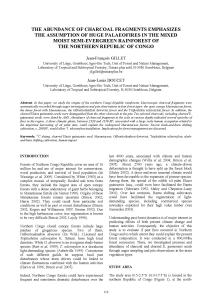In this paper, we study the origins of the northern Congo Republic rainforests. Macroscopic charcoal fragments were systematically recorded through auger investigations and pits observations in four forest types: the open canopy Marantaceae forest, the dense forest with Marantaceae, the Gilbertiodendron dewevrei forest and the Triplochiton scleroxylon forest. In addition, the charred Elaies guineensis seeds were distinguished from the other charcoals in the pits. Ten selected charcoals, including charred E. guineensis seeds, were dated by AMS. Abundance of charcoal fragments in the soils at various depths indicated several episodes of fires in the region. A dryer climatic phase, between 2320 and 1330 BP, associated with a large scale human occupation related to the important harvesting of oil palm nuts, could explain the widespread Marantaceae forests. Recent slash-and-burn shifting cultivation, c. 200 BP, would allow T. scleroxylon installation. Implications for forest management are discussed.
Consultez la notice complète de l’article sur ORBi

